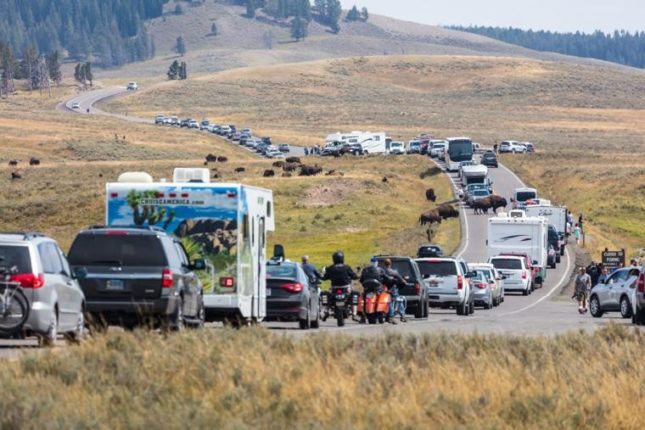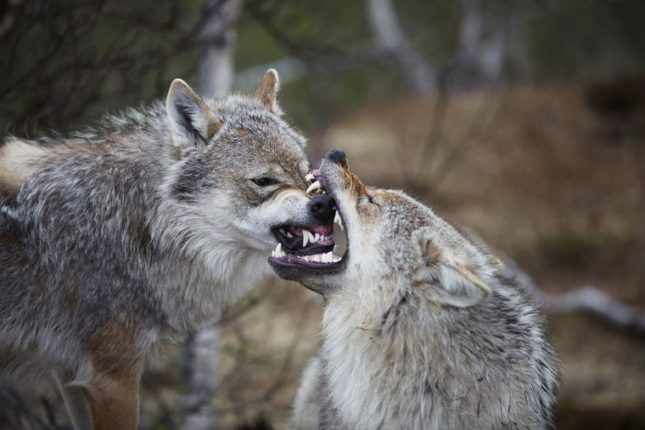BILLINGS, Mont. (AP) — Her parents may have been killed by her mate and his family. Her daughter was shot. Now she’s dead and her killing is under investigation.
Although the details may sound like the story line for a soap opera, a Shakespearean play or even the historical dirty deeds of Europe’s competing monarchies, it’s actually the tale of one of Yellowstone National Park’s well-known wolves — the white alpha female of the Canyon pack. Now, details of the park’s individual wolves and their inter-relatedness can be found in one place: online at Ancestry.com, a website formerly reserved for rooting out human family trees.
“People love their wolves,” said Jim Halfpenny, the founder of the Yellowstone Wolf Genealogy Family Tree.
That’s a sentiment Yellowstone officials have recognized, as well.
“I am amazed at the interest level in Yellowstone wolves,” said biologist Doug Smith, who leads the Yellowstone Wolf Project. “It’s insatiable.”
He noted that questionnaires distributed by the park in the early 2000s revealed that about 300,000 come to Yellowstone hoping to see wolves. Park interpreters annually talk to anywhere from 30,000 to 50,000 people a year about wolves.
It’s easy to see why there’s such an interest, Smith told The Billings Gazette (http://bit.ly/2rFhoNL).
“If you come to Yellowstone and put in a few days, you can see a wolf — and that’s pretty remarkable.”
The popularity of his genealogy charts became apparent to Halfpenny, a Gardiner-based biologist, after he started recording the lineage of Yellowstone’s wolves when they were first reintroduced to the park in 1995 and 1996.
“Through the years I’ve produced these laminated charts, selling about 4,000 a year,” he said. Now folks can order them online.
He updates the data yearly, using information gathered from multiple sources, including the Yellowstone Wolf Project. That’s no small task considering there can be more than 100 wolves scattered across the park’s 2.2 million acres (890,308 hectares) each year. At their population peak there were more than 170 wolves inside Yellowstone.
“We started out trying to do it by volunteers, and it was too overwhelming,” Halfpenny said.
So using a Kickstarter project to fund development — 273 people contributed more than $26,000 — Halfpenny was able to “put online the lives, pedigrees and genealogy of the Yellowstone wolves for access of all fans,” according to the website. The digital information is “enormous in scope and the first of its kind in the world.”
Those interested can go to www.wolfgenes.info to learn more about the project. Perusing Ancestry.com requires the payment of a membership fee. The information is also now available on a cellphone app allowing wolf devotees to carry the data with them into the field.
Smith said he hadn’t been able to check out the website yet but noted that building family trees and genealogy for wolves that have never been captured and had their DNA tested — such as the white alpha female from the Canyon pack — means some of the data isn’t scientifically valid. Each year about 40 percent of Yellowstone’s wolves are captured and have DNA samples taken.
“For scientific purposes, this probably is not the place to go,” Smith said. “For avid wolf watchers this is great. And he’s probably right most of the time.”
But the park has to be more conservative in its approach to linking individuals, he added.
Halfpenny admitted that observations by even hardcore wolf watchers are sometimes incorrect. For example, a wolf spotted in 2007 was believed to be a female. When found dead it turned out the wolf was a male.
Although the stories of known wolves are presented on the website, Halfpenny said it is the “interconnections that are just amazing” to him.
Take the earlier mentioned alpha female of the Canyon pack as an example. She was found seriously injured inside the park near Gardiner on April 11. Park officials euthanized the white wolf because her injuries were so severe.
A necropsy later revealed she had been shot. Two $5,000 rewards, one from the National Park Service and another from a private group, have been offered for information leading to the arrest and conviction of the wolf’s killer.
Even before her tragic death, the 12-year-old wolf had led a life worthy of an epic poem. Two years after being born into the Hayden pack her parents were killed by the rival Mollie’s pack. This is known as intraspecific mortality, when wolves kill wolves, and accounts for about 42 percent of all wolf deaths in Yellowstone — more than any other single factor.
The white female is believed to have later bred with an unknown black wolf from Mollie’s pack — the same wolves that had killed her parents.
For some reason the white alpha female’s first pairing didn’t last, and she found a new mate, who also was a member of the Mollie’s pack — 712M. Together with another Mollie’s male in 2008 they formed the Canyon pack in the center of the park.
It took two years for the Canyon pack to successfully raise a litter of three pups past a year old. One would later become the white alpha female of the Wapiti Lake pack who would eventually displace her own parents from their Canyon pack homeland.
In 2011 the Canyon pack produced two more pups, one of which was a female that seemed especially enamored with her father, earning her the nickname Daddy’s Girl. At age 2 this female wolf was shot by a rancher north of Gardiner.
“In 2016 this amazing alpha pair produced two more pups in their new denning area at the advanced ages of 11 and 10 (the Canyon Alpha Female was the older of the two),” according to the Yellowstone Wolf Genealogy site. “2016 also represented another milestone: the Canyon Alpha Female and 712M had been together as an alpha pair for eight years, making them the longest mated pair on record for Yellowstone wolves.” The female is believed to have given birth to at least 13 pups over the course of her life.
There’s rarely a happy ending in a wolf’s short life, though. Rejected by her own pack this past winter, the alpha female was seen roaming the Gardiner area alone, sometimes feeding on roadkill. Her mate, “712M was last seen in January 2017 just east of Mammoth Hot Springs. He would be 11 years old in April 2017,” the website noted.
The oldest known wolf in Yellowstone, 478F, lived to age 12.5. The average lifespan for park wolves is two to three years.
“I’m fascinated with it, following the family lines,” Halfpenny said.
The intrigues include female wolves mating with their fathers, grandfathers and even brothers.
“There are all sorts of complexities to this,” he said.
For each wolf recorded on the website there is a life story to be read, as well as facts and a photo gallery if shots are available. Adapting such complex family relations to a website was a challenge since the Ancestry.com formula was set up for humans who give birth to about one offspring a year, not 4.4 a year, which is the average litter size for Yellowstone wolves.
“So we had to work around problems like that,” Halfpenny said.
He compared the information to tracking the Smith family tree for all of North America.
___
Information from: The Billings Gazette, http://www.billingsgazette.com

